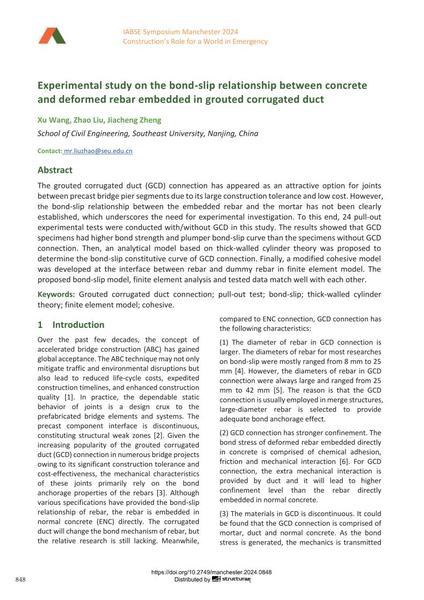Experimental study on the bond-slip relationship between concrete and deformed rebar embedded in grouted corrugated duct

|
|
|||||||||||
Bibliographic Details
| Author(s): |
Xu Wang
(School of Civil Engineering, Southeast University, Nanjing, China)
Zhao Liu (School of Civil Engineering, Southeast University, Nanjing, China) Jiacheng Zheng (School of Civil Engineering, Southeast University, Nanjing, China) |
||||
|---|---|---|---|---|---|
| Medium: | conference paper | ||||
| Language(s): | English | ||||
| Conference: | IABSE Symposium: Construction’s Role for a World in Emergency, Manchester, United Kingdom, 10-14 April 2024 | ||||
| Published in: | IABSE Symposium Manchester 2024 | ||||
|
|||||
| Page(s): | 848-854 | ||||
| Total no. of pages: | 7 | ||||
| DOI: | 10.2749/manchester.2024.0848 | ||||
| Abstract: |
The grouted corrugated duct (GCD) connection has appeared as an attractive option for joints between precast bridge pier segments due to its large construction tolerance and low cost. However, the bond-slip relationship between the embedded rebar and the mortar has not been clearly established, which underscores the need for experimental investigation. To this end, 24 pull-out experimental tests were conducted with/without GCD in this study. The results showed that GCD specimens had higher bond strength and plumper bond-slip curve than the specimens without GCD connection. Then, an analytical model based on thick-walled cylinder theory was proposed to determine the bond-slip constitutive curve of GCD connection. Finally, a modified cohesive model was developed at the interface between rebar and dummy rebar in finite element model. The proposed bond-slip model, finite element analysis and tested data match well with each other. |
||||
| Keywords: |
finite element model Bond-slip pull-out test Grouted corrugated duct connection thick-walled cylinder theory cohesive
|
||||
